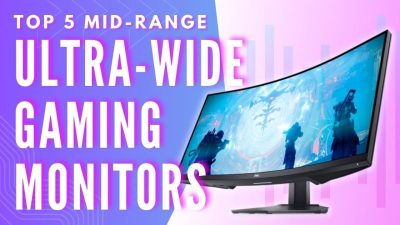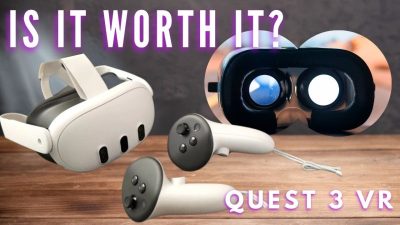📢 Disclosure: Some links on this page are affiliate links. As an Amazon Associate, I earn from qualifying purchases at no extra cost to you. Thanks for your support.
Are they still worth it in 2025?
Augmented reality (AR) glasses are becoming smaller, sleeker, and more practical than traditional VR headsets, making them an appealing option for those looking to replace TVs or monitors with a more immersive experience. Among the most popular AR glasses right now are the Rokid Max, boasting a cinema-like display, high refresh rates, and strong gaming performance.
But are they the best AR glasses available? You can check out our full guide of best AR and MR smart glasses by reading our article here.
Let’s continue reading below to take a closer look at their design, features, and performance to find out.
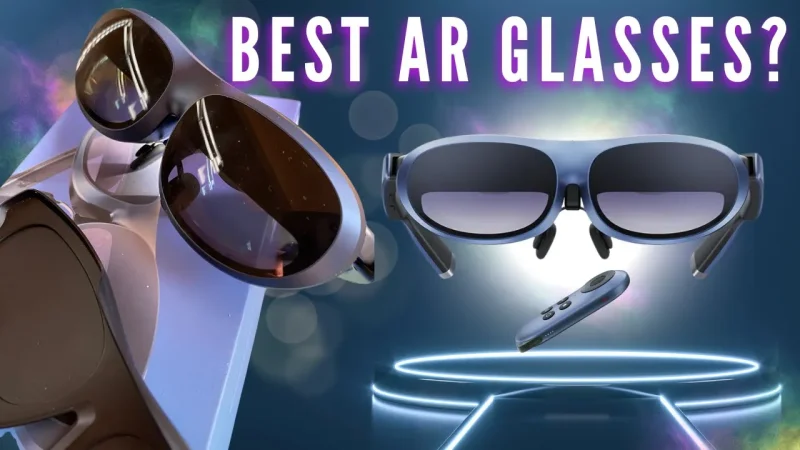
First impressions: A portable cinema experience
Right off the bat, the Rokid Max AR glasses create the illusion of watching a 215-inch display thanks to their micro-OLED technology. With the included blackout cover, the experience feels like a mini-theater. Without the cover, the image remains sharp, but external light exposure can make it harder to see clearly, especially in bright environments.
Unlike some AR glasses that allow for walking and viewing, the Rokid Max are best suited for stationary use. This makes them ideal for gaming, movies, and entertainment, but less so for on-the-go augmented reality applications.
Please note: Product visuals, specifications, and descriptions can change over time. All information is provided for reference; confirm the latest details on the live product page.
New Rokid Spatial AR glasses
The Rokid AR Spatial Glasses are a bold step forward from the Rokid Max, offering more than just immersive entertainment. Designed to feel like a laptop you wear on your face, they combine the visual clarity of the Max series with powerful multitasking features. They weigh about 75g and are built from aerospace-grade materials, giving them a light but premium feel that stays comfortable even during extended sessions.
What really sets them apart is their pairing with the Rokid Station 2, an upgraded external hub that unlocks multi-window spatial computing. That means you can connect a Bluetooth keyboard and mouse, run multiple screens in augmented space, and even control things with your voice. It’s a far cry from simply watching movies, it’s more like working from a virtual desktop environment.
The glasses also retain key visual features like diopter and IPD adjustment, but go a step further with support for streaming apps and even Google services in select models. The onboard hardware (8GB RAM / 128GB storage) gives them more muscle than your average AR companion. Yes, they cost more, but you’re getting a highly capable portable productivity and entertainment system in return.
Compared to the Rokid Max, which leans more toward passive viewing and gaming, the Spatial Glasses are built for users who want to create and work, not just consume. The android based system gives a much more interactive space, similar to that of the quest app, and takes these glasses to the next level.
How do Xreal One Pro compare?
If you’re looking for something more stylish, the new XREAL One Pro offer a nice middle ground. Unlike the bulkier design of the Rokid Max, the One Pro looks and feels like a high-end pair of Ray-Bans, complete with multiple nose grips and a flat-prism frame that fits naturally on your face. It’s the kind of AR glasses you could actually wear out in public without drawing stares.
In terms of visuals, the One Pro takes things up a level. It features a wider 57° field of view, up to 700 nits brightness, and a 120Hz refresh rate, delivering crystal-clear visuals with minimal distortion even around the edges. That wider FOV creates a more cinematic feel and gives everything, from games to spreadsheets, a bit more breathing room.
Audio is another standout. The built-in Bose-tuned speakers offer a rich sound experience, while electrochromic dimming allows the lenses to darken automatically based on lighting, giving you better control and privacy when watching content or gaming.
That said, they are at a similar price to the new Rokid AR Spatial glasses and it doesn’t include built-in focus adjustment, which might be an issue for users who need vision correction. You’d need external lens inserts, unlike the Rokid Max’s adjustable dial.
But overall, if screen clarity, sound and style are your focus, the XREAL One Pro is for users who want the best optics, comfort, and style, and don’t mind paying a bit more for it. It’s less of a media-only device and more of an all-around upgrade, refined, balanced, and built for the times.
So what about the origional Rokid Max AR glasses?
Let’s start with the design…
One noticeable drawback of the Rokid Max is its larger frame compared to competitors like the XREAL Air 2 Pro. Unlike some foldable AR glasses, these do not fold completely due to their bulkier design. When worn, they stand out more visibly than other AR models, which may be a consideration for those who prefer a subtler look.
That said, they sit comfortably on the head, and the built-in focus adjustment dial is a great feature, especially for those who wear prescription glasses. If additional vision correction is needed, prescription lens add-ons are available.
Display & performance: Immersive, but with some blurring
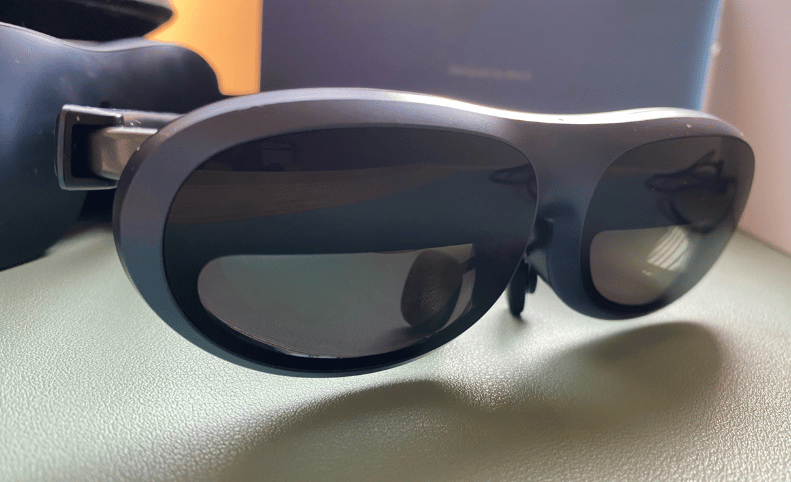
The Rokid Max AR glasses feature an impressive:
✅ Micro-OLED Display – Delivers full HD 1080p resolution with vibrant colors.
✅ 120Hz Refresh Rate – Provides smooth frame rates (great for gaming).
✅ 600 Nits Brightness – Ensures a bright and vivid display.
✅ 50° Field of View (FOV) – Creates an immersive theater-like experience.
The image quality is excellent, but there is some blurring around the edges, making it difficult to achieve perfect clarity across the entire screen. This might be due to the rigid fit of the glasses, as they don’t wrap around the head like a VR headset would.
The focus adjustment toggle is a unique feature that helps refine clarity, but it may not completely eliminate blur for all users. Competitors like the XREAL Air 2 Pro lack this feature, making the Rokid Max a good choice for those who need vision adjustment.
Typing & productivity: Not ideal for work use
One downside of using AR glasses for work or productivity is the typing experience. When using the Rokid Max for tasks like writing or coding, you end up looking down at your keyboard frequently. Even for touch typists, it takes some time to get used to, making them less practical for extended office use.
However, for watching movies, gaming, or streaming, the experience is excellent.
Sound quality: Impressive, but some leakage
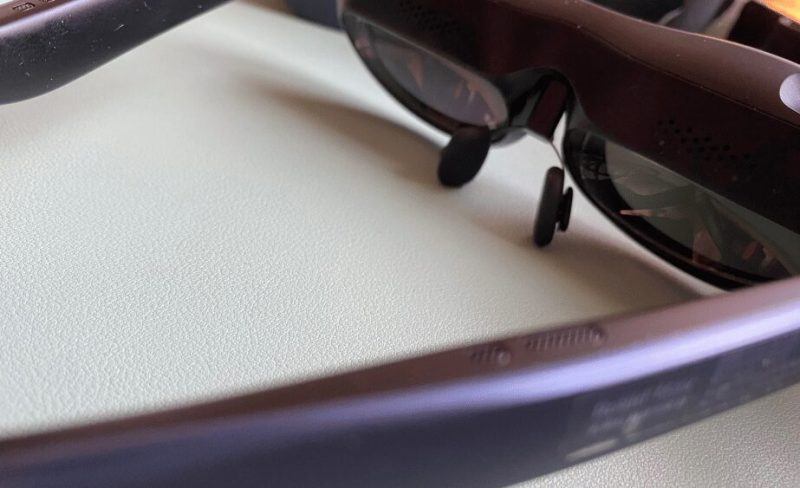
The built-in speakers on the Rokid Max deliver surprisingly good sound quality.
✅ High volume output – Strong enough for immersive viewing.
✅ Side-mounted volume buttons – Easy to adjust.
However, there is some sound leakage, comparable to having a phone on low volume nearby. While not extremely loud, those sitting close may hear audio spillover, which may be an issue in public spaces.
Gaming performance: 120Hz for smooth gameplay
One of the biggest advantages of the Rokid Max over other AR glasses is its 120Hz refresh rate, making it ideal for gaming.
However, not all gaming devices support 120Hz output. For example:
- The Steam Deck does not support 120Hz, limiting the benefits.
- The ASUS ROG Ally, on the other hand, can run at 120Hz, making it a perfect match for these glasses.
If you’re a gamer, make sure your device supports high refresh rates before purchasing.
3D mode: A fun feature
Holding the side button enables 3D mode, which enhances depth perception for a truly immersive experience. Combined with the cinema-sized display illusion, this makes the Rokid Max a great alternative to a home theater setup.
The illusion of sitting mid-row in a theater is impressive, but it’s worth noting that after extended use, the effect may feel less noticeable over time.
Comfort & heat issues: A drawback for long sessions
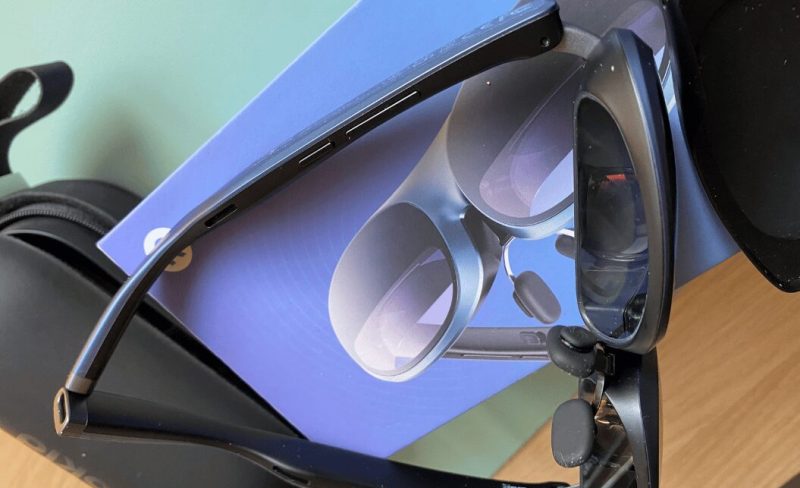
Wearing the Rokid Max for longer than 10 minutes, you may feel heat buildup at the bridge of your nose.
- While not dangerously hot, the warmth can cause mild discomfort.
- The XREAL Air 2 Pro heats up on the sides instead, which may be a better design choice.
For extended use, taking breaks is recommended to avoid strain.
Compatibility: Works best with USB-C devices
The Rokid Max AR glasses connect via USB-C, but there are some compatibility concerns:
- Android, Windows, and Steam Deck work without issues.
- iPhones (iPhone 14 or older) require an adapter for connectivity.
For a standalone experience, the Rokid Station can be used. This compact entertainment hub provides 5 hours of battery life and supports various streaming apps.
Overall
✔ Pros:
✅ Cinematic 215-inch display illusion
✅ 120Hz refresh rate (great for gaming)
✅ Micro-OLED technology with vivid colors
✅ Focus adjustment toggle for vision correction
✅ Surprisingly good built-in speakers
✖ Cons:
🚫 Not ideal for typing/productivity
🚫 Some blurring at the edges of the display
🚫 Heats up after extended use
🚫 Sound leakage at high volume
🚫 Limited iPhone compatibility (needs adapter)
Who Should Buy the Rokid Max?
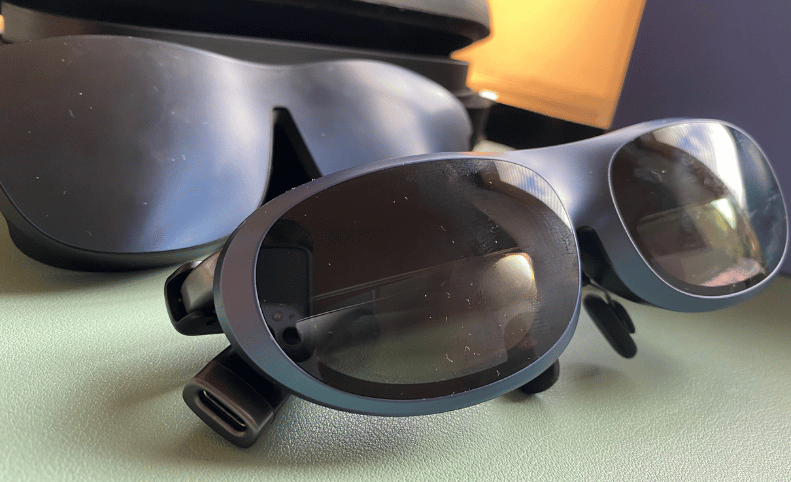
These Rokid Max glasses seem like they’ve been made for gaming on the go, they are particularly fitting with devices like the Steam Deck and Asus Rog Ally which are handheld PC/Gaming devices. I say that because of their good refresh rate, and large screen size. But they’re also awesome for people who just want to watch movies on the go and they make an great portable solution for a large screen TV when travelling too.
But if you want something for office work or if you’re looking for a pair of smart glasses to take on outdoor hikes, these aren’t for that. Typing becomes laborious and glasses like the Meta Ray Bans are more suitable for outdoor functionality with their AI tech.
For more options on smartglasses check out our guide on the best AR and MR smart glasses.
A step forward, but AR glasses aren’t perfect yet
The Rokid Max AR glasses are a significant step forward in AR technology, offering a high-quality display, great refresh rate, and immersive experience. However, they still fall short in everyday usability, especially for work.
If you’re looking for an AR gaming and entertainment solution, the Rokid Max is among the best AR glasses available in 2025. However, for those seeking an all-in-one AR productivity tool, the technology still has room for improvement.
We hope this article review on the Rokid Max AR glasses helped you. Oh and by the way! Looking for a new laptop instead? Try our Laptop Finder Quiz and be matched with instant recommendations. Otherwise check out our related articles on the links below:

